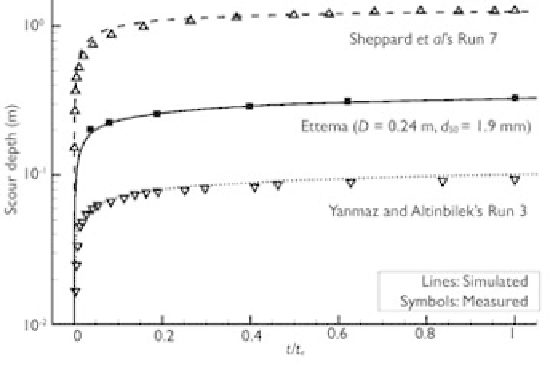Geoscience Reference
In-Depth Information
s
−
1
, and an approach flow depth of 0.135m.
The simulated scour depth contours in the hole agree well with those measured. The
simulation predicted deposition downstream of the scour hole, but the measurement
lacked this information. Fig. 7.15 compares the simulated and measured deepest scour
depths varying with time for Yanmaz and Altinbilek's (1991) Run 3, Ettema's (1980)
experiment with
D
size of 1.07mm, a flow discharge of 30 l
·
=
2.9mm) of Sheppard
et al
. Durations (
t
e
) of these three runs were 5, 14.5, and 188 hr,
respectively. Erosionwas very intensive at first and then reduced gradually. The erosion
processes were reproduced well by the numerical model.
=
0.24m and
d
50
=
1.9mm, and the Run 7 (
D
=
0.91m,
d
50
Figure 7.15
Temporal variation of the deepest scour depth at cylindrical piers.
cr
and
τ
be
and that using Eqs. (7.69) and (7.70) do not have significant difference in terms
of the predicted maximum scour depth at bridge piers. This is due to the fact that the
local scour is induced by other factors, such as downward flow and localized dynamic
pressure gradient. In contrast, the bed slope effect may reduce the predicted local
scour depth because of the inverse bed slope in the downstream of the scour hole. The
results shown in Figs. 7.14 and 7.15 were obtained with the approach using Eqs. (7.63)
and (7.68).
Tests have also shown that the approach using Eqs. (7.63) and (7.68) for
τ
7.4.3 Headcut migration model
A headcut is a vertical or near-vertical drop or discontinuity on the channel bed
of a stream, rill, or gully at which a free overfall flow often occurs, as shown in
Fig. 7.16. The headcut is usually eroded by the action of hydraulic shear, basal sap-
ping, weathering, or a combination of these processes. Headcut erosion can accelerate
soil loss, increase sediment yields in streams, damage earthen spillways, and disturb
bank stability.
De Ploey (1989) and Temple (1992) established empirical formulas by relating the
headcut migration rate to the energy head change at the headcut. The coefficients

